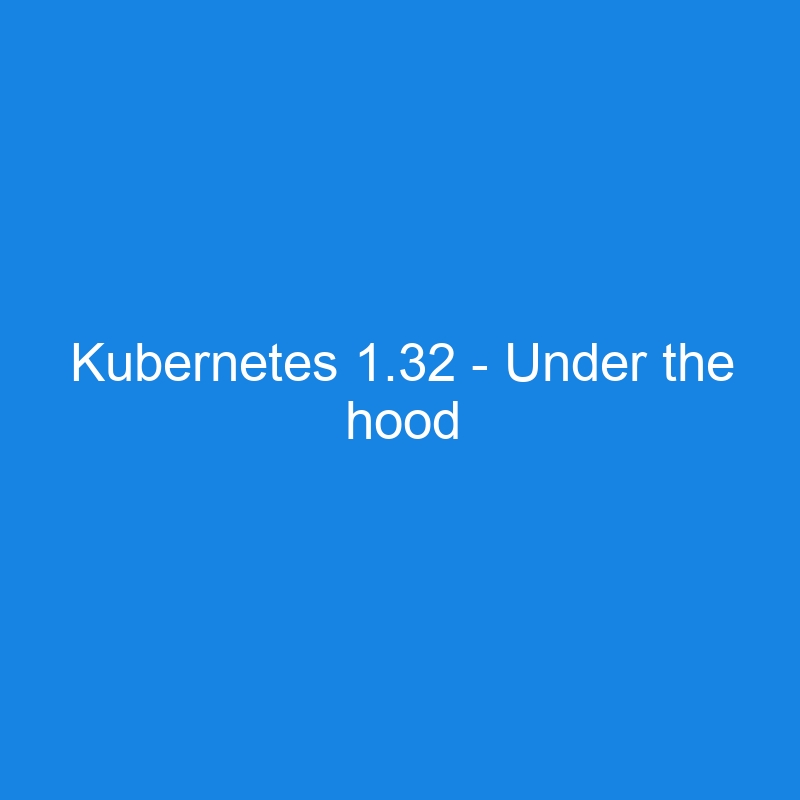Kubernetes 1.32: A Symphony of Stability and Subtle Enhancements 🎶
The Kubernetes world is buzzing with the arrival of version 1.32, affectionately nicknamed “Penelope” after the patient wife of Odysseus, the Greek navigator (Kubernetes itself means “navigator” in Greek!). While this release might not be as groundbreaking as some of its predecessors, it’s packed with subtle enhancements and stability improvements that signify the project’s maturity. Let’s delve into the key takeaways from this release, demystifying the jargon along the way.
Dynamic Resource Allocation (DRA): Embracing Flexibility 💪
Imagine you’re packing for a trip. Instead of meticulously planning every item and its exact weight, you opt for a flexible suitcase that expands as needed. That’s the essence of Dynamic Resource Allocation (DRA) in Kubernetes. It allows workloads to request resources dynamically, rather than specifying rigid limits upfront. This is especially beneficial for workloads using specialized hardware like GPUs, FPGAs (think high-performance chips for specific tasks), and network adapters.
DRA, now in beta, enables the Kubernetes scheduler and autoscaler to handle resource claims for specialized hardware without needing third-party drivers. This eliminates dependencies, simplifying cluster management. Kubernetes 1.32 introduces improvements to DRA, including the addition of resource health status in the Pod status, as outlined in KEP #4680.
Think of DRA as a smart resource manager for your Kubernetes cluster. It ensures that your pods get the resources they need when they need them, without over-provisioning or under-utilization.
However, careful planning is crucial, especially when dealing with varying resource demands of different programming languages like Java, Go, and Python. For instance:
- Java applications, known for their memory consumption, might require a more generous resource allocation range to accommodate fluctuating loads.
- Go applications, often designed for efficiency, might operate well within tighter resource boundaries.
- Python applications, with their flexibility in handling diverse tasks, could demand a more adaptable resource allocation strategy.
Platform engineers need to understand the nuances of their workloads and configure DRA cautiously to ensure optimal performance without compromising efficiency.
| Perspective | Impact of DRA |
|---|---|
| Platform Engineer | Simplifies infrastructure management, improves resource efficiency, and reduces operational overhead. |
| End User | Enhances application performance and scalability, allows for greater flexibility in resource usage. |
Important notes on DRA:
- The old DRA implementation, introduced in Kubernetes 1.26, is being replaced with the Structured Parameter model in Kubernetes 1.32. This change improves compatibility with cluster autoscaling.
- Downgrading from Kubernetes 1.32 to 1.31 with DRA resources in the cluster is not supported.
Graceful Shutdown for Windows Nodes: No More Abrupt Exits 👋
Previously, shutting down a Windows node in a Kubernetes cluster was like pulling the plug on a running computer – abrupt and potentially disruptive. Kubernetes 1.32 introduces graceful shutdown for Windows nodes, ensuring that pods are terminated gracefully, allowing for cleanup tasks and state preservation before the node goes offline.
For both platform engineers and end users, this enhancement translates to improved reliability and workload consistency.
Volume Management Enhancements: Keeping Your Data Safe and Sound 🔐
Kubernetes 1.32 brings several improvements to volume management, focusing on data safety and consistency. A new feature allows for recovery from volume expansion failures, minimizing data loss or corruption when expanding storage capacity.
Additionally, the Volume Group Snapshot feature graduates to Beta. This allows for taking consistent snapshots of multiple volumes together, simplifying backup and recovery operations for complex applications that span multiple storage units. Imagine backing up a live, bustling city without disrupting its daily life – that’s analogous to the Volume Group Snapshot capability. It allows taking a consistent snapshot of multiple volumes associated with an application, like a running database, without requiring downtime.
This feature is particularly beneficial for tools like Velero, which specialize in Kubernetes backup and recovery. By leveraging Volume Group Snapshots, Velero can streamline the process of backing up complex applications, ensuring data consistency and minimizing the impact on running services.
| Feature | Benefit |
|---|---|
| Recovery from Volume Expansion Failures | Minimizes data loss or corruption during storage expansion. |
| Volume Group Snapshot | Simplifies backup and recovery of applications using multiple volumes. |
Details about the Volume Group Snapshot feature:
- The API is designed to work with CSI Volume Drivers.
- The intention is to provide the ability to capture consistent group snapshots without affecting application performance.
Quality of Life Improvements: Smoother Sailing for Everyone ⛵
Kubernetes 1.32 is brimming with quality of life improvements that might seem small but have a significant impact on the overall user experience. Here are a few noteworthy examples:
- Improved Image Pull Backoff Error Reporting: When an image fails to pull, Kubernetes now provides more human-friendly error messages, aiding in faster troubleshooting.
- Automatic Removal of PVCs Created by StatefulSets: This feature simplifies storage management by automatically removing Persistent Volume Claims (PVCs) associated with deleted StatefulSets.
- Enhanced Support for Sidecar Containers: Sidecar containers are like helpful companions for your main application containers, providing additional functionality. Kubernetes 1.32 further refines support for sidecar containers, improving their lifecycle management and resource allocation.
Conclusion: A Step Towards a More Mature Kubernetes 🚀
While Kubernetes 1.32 may not boast flashy new features, it’s a testament to the project’s commitment to stability, reliability, and continuous improvement. The enhancements in DRA, graceful shutdown for Windows, volume management, and quality of life improvements collectively contribute to a more mature and user-friendly Kubernetes experience.
As the Kubernetes ecosystem continues to evolve, we can expect future releases to bring further refinements and innovations, solidifying its position as the cornerstone of modern cloud-native application development.
Other notable changes in Kubernetes 1.32:
- The scheduler implements
QueueingHintin the VolumeBinding plugin’s CSIDriver event, which enhanced the throughput of scheduling. - Support for specifying a custom network parameter when running e2e-node-tests with the remote option was added.
